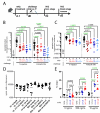Analysis of Fc-dependent effector functions of anti-malaria circumsporozoite protein antibodies
- PMID: 40698943
- PMCID: PMC12403835
- DOI: 10.1128/spectrum.00863-25
Analysis of Fc-dependent effector functions of anti-malaria circumsporozoite protein antibodies
Abstract
Antibodies targeting the malaria circumsporozoite protein (CSP) can prophylactically protect against malaria by targeting Plasmodium parasites before they establish symptomatic blood-stage disease. Engineering the antibody Fc region to more effectively engage immune effector functions has produced therapeutic antibodies with enhanced potency against viral and oncological targets. However, whether Fc-dependent immune effector functions can contribute to the protection of malaria CSP mAbs or be further enhanced via engineering has been limitedly tested. Here, we report that Fc-dependent effector functions are required for achieving maximal protection via prophylactic treatment with the CSP mAb 317. We further report that Fc engineering modulated the activity of multiple CSP mAbs in multiple in vitro assays of effector function. Our studies revealed that the mAbs L9 and CIS43 were more potent drivers of antibody-dependent phagocytosis, NK activation and killing, and complement deposition. In contrast, 317, but not L9 and CIS43, drove enhanced activation of CSP-responsive T-cells after DC acquisition of mAb-complexed antigens. Collectively, our data suggest that effector function represents an important mechanism of anti-CSP antibodies with the potential to enhance activity through Fc engineering.IMPORTANCEMalaria disease imposes a major burden on global health, causing over half a million annual deaths. Recent clinical trials in humans have shown that therapeutic antibodies can provide prophylactic protection against malaria in target populations. However, the cost of goods for therapeutic antibodies is high, and the malaria disease burden is concentrated in resource-challenged regions. Engineering the antibody Fc domain to more efficiently engage the immune system is an appealing strategy to increase the potency of therapeutic antibodies but has been minimally tested for malaria. Here, we present evidence that the Fc domain of malaria therapeutic antibodies can confer protection in animal models and can be engineered for more potent stimulation of diverse parasite-targeting immune responses.
Keywords: antibody functions; antimalarial agents; effector functions; malaria; monoclonal antibodies.
Conflict of interest statement
E.S., R.R., B.W., H.D., A.D.M., L.S., K.C., S.B., Q.C., T.T., E.C. M.A.S., R.G., J.L.M., and L.L.D. are current or former employees of Vir Biotechnology and may own shares in Vir Biotechnology. L.A.P is a former employee of and may hold shares in Regeneron Pharmaceuticals and Vir Biotechnology and is a member of the scientific advisory board of the AI-driven Structure-enabled Antiviral Platform (ASAP) group. A.B.Z. is a former employee of and may hold shares in Regeneron Pharmaceuticals and Vir Biotechnology.
Figures






References
-
- Datoo MS, Dicko A, Tinto H, Ouédraogo J-B, Hamaluba M, Olotu A, Beaumont E, Ramos Lopez F, Natama HM, Weston S, et al. 2024. Safety and efficacy of malaria vaccine candidate R21/Matrix-M in African children: a multicentre, double-blind, randomised, phase 3 trial. Lancet 403:533–544. doi: 10.1016/S0140-6736(23)02511-4 - DOI - PubMed
MeSH terms
Substances
Grants and funding
LinkOut - more resources
Full Text Sources
Medical

